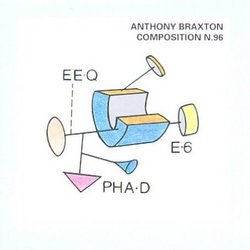| All Artists: Anthony Braxton Title: Composition No. 96 Members Wishing: 2 Total Copies: 0 Label: Leo Records UK Release Date: 6/14/1997 Genres: Jazz, Pop Styles: Avant Garde & Free Jazz, Swing Jazz Number of Discs: 1 SwapaCD Credits: 1 UPC: 5024792016921 |
Search - Anthony Braxton :: Composition No. 96
 | Anthony Braxton Composition No. 96 Genres: Jazz, Pop
|
Larger Image |
CD Details |
CD ReviewsBraxton's Notated Music Christopher Forbes | Brooklyn,, NY | 08/13/2002 (3 out of 5 stars) "This is an interesting album, even if it's not fully engaging. Braxton is increasingly revealing himself to be a musician of power who breaks all stylistic barriers. His influence on the avant-garde jazz movement is tremendous. And yet, though he has been writing notated music of power and passion for over 30 years, he has yet to recieve the acclaim due him in avant-garde classical circles. This is a shame, because, even in music that doesn't quite work, Braxton is a powerhouse to be reckoned with.Composition No. 96 is an uneven work. Like so many of Braxton's pieces, it is named primarily by a symbolic graphic that is connected to the work's mystical meaning, but referred to by number. People looking for Braxton to blow in this album will be disappointed. He appears as conductor, but never plays his saxes at all on the work. Instead, the piece is written for a 37 piece orchestra of winds, brass and a smallish stringed section. The result sounds like a cross between a classical chamber orchestra and a big band, with wind sonorities dominating. The piece is also to be accompnied by 4 slide projectors on which photographs of important esoteric symbols are shown, along with photographs from nature in which these symbolic forms can be found. The music is divided into four notationed sections, separated by three "fermata" improvised sections. The notated sections set up continuous stands of music against each other, much as Ligeti's Melodien or San Francisco Polyphony. Some of these melodic strands are harmonized in block chords, resembling an outer space "Supersax" group. The improvised sections are moments of stasis and are perhaps the most striking thing about the piece. They enter out of nowhere. The musicians hold out a long chord, improvising mostly with the tone color and dynamics of the chord. The fermatas last as long as two minutes, and yet they are endlessly fascinating. The stasis is needed after the density of the main sections.For all of it's inventiveness, this work ends up lacking a drive. It sounds more conceptual than organic. The melodic" lines have very little relationship to each other. This non-motivic approach to melody has been tried by others as well, most notably Ligeti. But the approach is varied in Ligeti's work by changes in tempo and texture. Absent that, Braxton's piece can begin to wear by the third or fourth section. I find myself wishing for the end long before it finally comes.So, though I love many of Braxton's notated pieces, and believe that he has a key to the future uniting of improvised and composed music in all styles, I find Composition 96 to be a disappointment. I'm glad I've heard it, but wish that I hadn't actually bought it. There are other CDs of Braxton's that I would rather own."
|

 Track Listings (1) - Disc #1
Track Listings (1) - Disc #1